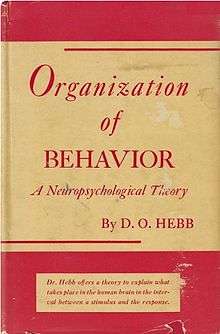Organization of Behavior
 Cover of the first edition | |
| Author | Donald O. Hebb |
|---|---|
| Language | English |
| Subject | Learning |
| Published | 1949 |
| Media type | Print (Hardcover and Paperback) |
| Pages | 378 (2002 Psychology Press edition) |
| ISBN | 978-0805843002 |
Organization of Behavior is a 1949 book by psychologist Donald O. Hebb, in which Hebb introduces his theory about the neural bases of learning, which is now commonly known as "Hebb's postulate".[1]
Summary
Hebb proposes that whenever conditioned reflexes are established in an organism through learning, a new anatomical substratum is established in the brain through a physiological process in which weak or non-existent synapses are strengthened by biochemical modification or by permanent changes in their electrical properties. Learning, according to Hebb's hypothesis, is not simply something impressive upon a passive brain, but a process in which the cellular structure of the brain is permanently modified.[2]
Scholarly reception
Organization of Behavior is the most influential outline of Hebb's hypothesis. Author Richard Webster comments in Why Freud Was Wrong (1995) that the hypothesis has classic status within science and is supported by recent research.[2]
References
Footnotes
- ↑ Hebb 1949.
- 1 2 Webster 2005. p. 487.
Bibliography
- Books
- Hebb, Donald (1949). The Organization of Behavior. New York: Wiley & Sons.
- Webster, Richard (2005). Why Freud Was Wrong: Sin, Science and Psychoanalysis. Oxford: The Orwell Press. ISBN 0-9515922-5-4.